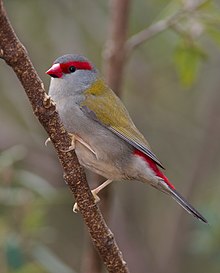Dornastrild
| Dornastrild | ||||||||||||
|---|---|---|---|---|---|---|---|---|---|---|---|---|

Dornastrild |
||||||||||||
| Systematics | ||||||||||||
|
||||||||||||
| Scientific name | ||||||||||||
| Neochmia temporalis | ||||||||||||
| ( Latham , 1801) |
The Dornastrild ( Neochmia temporalis ), also called Dornamadine , is an Australian species from the finch family . It is a very adaptable species that is very common in places and is also found in the suburbs of larger cities. Three subspecies are distinguished.
description
The Dornastrild reaches a body length of up to twelve centimeters. There is no noticeable gender dimorphism .
Males and females have a broad, bright red eyebrow stripe. The rump and the tail-coverts are red, the top of the head to the nape of the neck is gray. The back and wings, on the other hand, are olive green. The wings are dark and each has a greenish outer edge. The tail is black-brown. The sides of the head, throat and the rest of the underside of the body are light gray to bluish-gray. The middle of the abdomen is yellowish.
Young birds are dark greenish-gray on the upper side of the body, only the rump is reddish.
Distribution and geographic variation
The range of the Dornastrilde stretches in the east of Australia from the Cape York Peninsula to Queensland and New South Wales to Victoria and Southeast Australia. They are also found on Kangaroo Island . The subspecies Neochmia temporalis minor colonizes the region from the Cape York Peninsula to Cairns . The subspecies Neochmia temporalis temporalis occurs from central eastern Queensland to Victoria and the third subspecies, Neochmia temporalis loftyi, lives on Kangaroo Island and in the Mount Lofty Range in eastern South Australia.
Dornastrilde have also been naturalized as captive refugees in the Darling Range between Bickley and Mundaring Weir near Perth since 1960.
habitat
Dornastrilde, like the Australian zebra finches, are very adaptable birds. Accordingly, they colonize a large variety of habitats and occur, among other things, in clearings in rainforests, on the edges of forests, in sparse forests, in pine plantations, in park landscapes and in the forest and bush strips along rivers and lakes. You can cope with the tropical climate in northern Queensland as well as with the temperate climate of South Australia with its relatively harsh winters. The Dornastrild can be regarded as a cultural follower and is one of the most common species in the suburbs in Sydney , for example .
food
The diet consists of semi-ripe and ripe seeds of a wide range of grasses and herbs. The animals also eat the seeds of plant species introduced into Australia. They pick them up directly from the ground or pick them up straight from the ears by climbing on the plant stems.
Reproduction
While the Dornastrilde occur outside the breeding season in flocks of 200 to 300 birds and are then occasionally associated with other species of finch, they live in pairs or in small groups during the breeding season. However, they are very sociable even during this time. They often breed in small clusters of several pairs with closely spaced nests. The observed minimum distance of the nests is only eighty centimeters.
The breeding season varies depending on the distribution area. In tropical Australia it falls in the second half of the rainy season. On the other hand, the thorny tribes found in the suburbs of Sydney breed almost all year round with the exception of the two coldest months of July and August due to the rich food supply that is available all year round.
A halmbalz belongs to courtship. The male carries a blade of grass or alternatively a feather in its beak and dances in front of the female. During this courtship, the female repeatedly throws her head upwards so that her beak briefly points almost vertically upwards. Presumably these are rudiments of a female courtship dance like the one known from the African Astrildas .
If possible, the nest is built inside dense bushes and is usually between 1.5 and two meters above the ground. The clutch consists of four to six white eggs. The young leave the nest at around 21 days. They are then still unable to fly and move awkwardly even in the branches.
The domestic cat and the banded goshawk, which were introduced in Australia, are among the most important predators of the red- thorn . This Australian hawk comes down from a low altitude on the birds foraging on the ground.
attitude
The Dornastrild was first introduced in Germany in 1870, but had already been on the market several times in England. After that it was never on the market and was almost completely missing for years. The Dornastrild is considered unsuitable for keeping in common with other fine finch species, because it usually chooses the highest calorie food and becomes fat within a short time.
supporting documents
literature
- Jürgen Nicolai (Ed.), Joachim Steinbacher (Ed.), Renate van den Elzen, Gerhard Hofmann: Prachtfinken - Australia, Oceania, Southeast Asia. Eugen Ulmer Verlag, Stuttgart 2001, ISBN 3-8001-3249-4 .
- Peter Clement , Alan Harris, John Davis: Finches and Sparrows. An Identification Guide. Christopher Helm, London 1993, ISBN 0-7136-8017-2 .
Web links
- Neochmia temporalis in the endangered Red List species the IUCN 2009. Posted by: BirdLife International, 2009. Retrieved on July 1 of 2010.
- Videos, photos and sound recordings on Neochmia temporalis in the Internet Bird Collection


